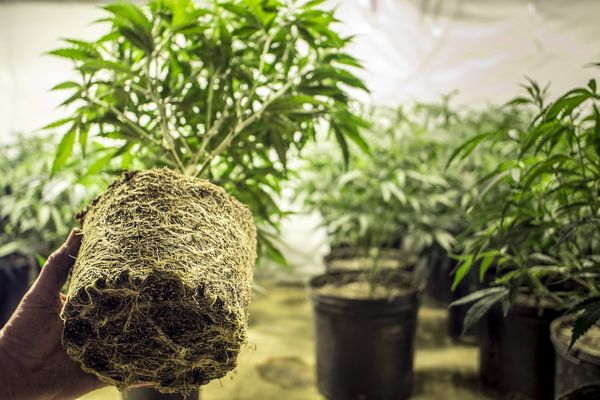- The therapeutic properties of marijuana are hardly new. Yet with legalisation knocking on the door of many countries around the world, deeper, more documented research is now possible.
- Although current treatments are based on the healing properties of the leaves and flowers, new research projects focusing on the roots are being developed, following the footsteps of a research line that dates back to almost 5000 years ago.

The first references to cannabis consumption date as far back as 2700 b.C. in China, with Shennong pên Ts'ao ching, one of the oldest Chinese medicine books, mentioning the use of the roots of cannabis as a remedy to soothe pain. The Chinese used the entire plant for their medicinal preparations, but they paid particular attention to the roots, which required more sophisticated processing. The roots were first dried, then ground to powder and mixed into a paste with fresh juice pressed from the same plant.
Throughout history, cannabis roots have been part and parcel of all sorts of homemade preparations. Their use as a remedy for skin rash was documented in ancient Greek medicine, and a medical article tells how Indians boiled them together with other leaves to make poultices for the treatment of inflamed skin surfaces. This practice is referred to in many recent studies, which highlight the painkilling and sedative properties of the roots for conditions such as skin rash and haemorrhoids.
In addition to paste, the Chinese used the roots for juice and ammunition. The juice pressed from the roots was used as a diuretic and even to stop bleeding during childbirth. The method was reviewed in 2002 by neurologist Ethan Russo, concluding that "the juice of the root is thought to have a beneficial action in retained placenta and post-partum haemorrhage."
But it doesn't stop here. The ancient Chinese exploited the cannabis plant to the point that they even used the roots as a component of gunpowder. Once dried, ground and toasted, they were mixed with bamboo roots, pine resin and other substances into ammunition for rockets and a sort of hand grenade they used in the military sphere.

Processing of cannabis roots
The drying and grinding of cannabis roots is a process that is still used in today's leap balms, creams and oils. Once crashed in a mortar and pestle, the roots are boiled in water and oil to dissolve the cannabinoids and terpenes. The resulting liquid is separated from the water and frozen, after which it is mixed with bee wax - for consistency - or spices. If you add let say black pepper, the result is a homemade remedy for arthritis or muscle pain.
You can also follow the teachings of ancient Chinese medicine and make yourself some restorative tea. Thoroughly clean the roots - of organically fertilized plants only -, chop them, crush them to powder and leave them to dry completely. And that's it, whenever you fancy a cup of tea, you'll only have to boil a small amount of the powder in 1L water.
In addition to tea, the roots are also suitable for making a kind of homemade beer. You just have to boil the powder with an aromatic substance - cinnamon sticks, anise, etc. - in a clay pot for 12 hours and strain the liquid. Leave it to cool and it will be ready to drink. And if you boil it once again, you will get a dark-coloured substance perfect for tinctures.
And speaking of inner cleansing, some present-day tribes still use the roots of cannabis as purgatives, a use that, curiously enough, is documented in Roman texts and has survived to present day. Particularly noteworthy is the case of the Aka, a pygmy hunter-gatherer people that live in the Congo Basin. According to a recent study by the Washington State University, the Aka consume cannabis as a way to prevent intestinal parasites, marijuana preparations being customary whenever they need to keep worms at bay.
Further, at the end of the 17th century the use of cannabis roots as a treatment against gonorrhoea was documented in Indonesia. Years later, the American colonists took over the baton and started using them to cure venereal disease. With so many references to the medicinal use of cannabis roots in different times and cultures, there is renewed scientific interest in the matter, along with greater opportunities to study the properties that have been hidden underground all this time.

The hidden anti-cancer properties of roots
The medicinal properties of the roots of cannabis differ greatly from the plant's other properties. Rather than with THC - almost non-existent in the roots - the medicinal properties of the roots have to do with their terpene composition. A study carried out in 1971 revealed that the roots contain a group of chemical compounds with antimicrobial, anti-inflammatory and painkilling effect. It also suggested that the ethanol extracted from the roots contained friedelin, an antioxidant terpene with hepatoprotective action.
But most striking of all was the discovery of a compound known as epifriedelanol, a potent antitumor agent. Laboratory tests with a plant similar to marijuana - Phyllanthus watsonii - showed that its components successfully inhibited the growth of colon cancer cells. The extract of this Malaysian plant contained friedelin and epifriedelanol, the same compounds that were found in cannabis roots.
Throughout the experiment, signs of apoptosis or cell suicide were also detected. While regular cells undergo apoptosis if harmed or diseased, cancer cells fail to respond to self-destruction signals, blocking the apoptosis process. Having obtained cannabis-induced apoptosis of malignant cells in a lab environment is thus a highly promising prospect.
As well as friedelin and epifriedelanol, the roots also contain pentacyclic triterpenes, a kind of fat-soluble molecule that has also been proven to induce apoptosis in cancer cells. Despite the need for further studies in the field, cannabis roots could well be a key element in the treatment of cancer.

Other benefits of cannabis roots
But the powers hidden in the lower part of the plant go far beyond this. Cannabis roots have also been proven to contain alkaloids, which could be used for the treatment of menopause, bronchial problems and diabetes, while hemp roots are relatively rich in CBD, the most widely used cannabinoid in modern medicine.
Most cannabis growers know very little about the many uses of the roots once they have fulfilled their role in the plant life cycle, but in actual fact they can be used in many ways right in the comfort of one's home. Homemade root lip balms are pretty easy to concoct, and if you prefer creams and oils, your skin will look more than radiant.
Legalisation is boosting the cannabis industry and increasingly more research is being carried out. As a result, the number of plant per patient and user is constantly increasing - and thus also the number of roots. Although at present the base of the plant is systematically discarded in almost all cannabis farms, the day will come when knowledge about the roots will be widespread enough for the cannabis industry to change its view on their marketing, making cannabis cultivation a far more cost-effective activity.



Comments from our readers
You have two major typos that can undermine your credibility. First is this: a pygmy hunter-gatherer people that "leaves" in the Congo. I believe they may live in the Congo. Following that is the use of "warms" instead of "worms". I would be happy to proof read other articles if desired.
Hi Craig, thank you for your comment. We are happy with our current content team, anyone can have a bad day ;). We do appreciate your remarks, though!
Read comments in other languages:
Did you like this post?
Your opinion about our seeds is very important to us and can help other users a lot (your email address won't be made public).